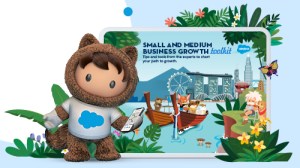A digital-first mindset can make your business more efficient, productive, and customer focused. More than 95% of companies that have digitally transformed their business with Salesforce have met or exceeded their ROI expectations.
In this article, Regional Vice President, ASEAN SMB, Thomas Lim explains how a digital-first mindset can help you grow your business, reduce costs, and delight your customers.
What does digital-first mean?
‘Digital-first’ is a phrase that you might hear a lot, but what does it really mean?
For me, it means two things:
- Offering a digital experience to your customers
Finding ways to provide your products and services to your customers on digital channels helps you gain a competitive advantage, especially post-Covid. More and more customers want to find products, make their purchases, and receive follow-up service, all online. You have to be able to do business on the channels that your customers are using, while also providing a seamless experience.
2. Digitalise your processes and operations
The second part is not customer facing. It’s the digitalisation of your processes and operations. It covers internal processes — the operations you go through to make your work happen. It also encompasses aspects of employee experience. Your customers probably won’t see these processes, but they’ll make your employees’ lives easier. Also, digital processes can help you scale your business in an efficient and effective way.
Think of a coin: one side is the customer-facing product and experience. The other side is the tools and processes you use to provide this service. One is powering the other.
Of course, it’s important that it’s the same coin — you don’t want misaligned faces that rub up against each other and cause friction.

What are the benefits of being digital-first?
One of the major benefits of being digital-first is that you can improve your customer intimacy thanks to digital insights.
When you start out as a small business, you might only have a handful of customers. You might rely on your gut feeling and your personal relationship with them, to understand what they want, and how you can serve them best.
This won’t work as your business grows. You might find it difficult to keep track of all that information. It’s also very difficult to share with your teams if it’s all in your head.
Also you may miss an opportunity to combine Small Data with the Big Data: in a digital world, your ability to collect more comprehensive data across all your customer touch points may be a game changer.
With the right CRM platform, you can extract useful insights and use them to make your customer experience better, refine your marketing, sales and service strategy and operations.
Digital insights for face-to-face customers
As an example, I spoke with a retail customer, who had recently expanded into ecommerce. They were able to take what they’d learned from their online customers (e.g. paths to purchase, product preferences, etc.) and apply it to their brick-and-mortar retail business.
Data-driven insights have a benefit beyond the digital delivery of your products and services. They can give you insights about trends, such as shoppers’ growing expectations for in-store contact-free shopping solutions like contactless and self-checkout options.
Improved efficiency
A digital-first mindset also allows you to be efficient. You can automate time-consuming admin tasks which will free you up to concentrate more on important aspects of your business.
With a unified view of customer data, there’s less opportunity for things to go by unnoticed. This is particularly important in sales — if you are keeping track of your prospects on separate systems, or even hard copies on paper, there is a huge risk for good leads to slip through the cracks. Having everything digitised, and with the power of automation, you can avoid losing or missing valuable leads.

How can I become a digital-first business?
The first thing you need to start with is your business culture. As a small business owner, you naturally want to work hard — that’s how you got your business off the ground. But as you scale up your business, it will get increasingly difficult to simply work harder. Even hiring more people to help you can only take you so far.
Second, it is important to have a long term and holistic view when considering your investment in technology. It may be tempting to purchase point solutions but you should make sure these solutions can seamlessly work in unison across your company. A better solution would be to invest in a platform that can grow with your business.
Which parts of my business should I digitalise first?
Looking at your business and trying to think about a full-scale digital transformation can be overwhelming.
I would encourage any SMB owner to approach their digital transformation in steps. And I would strongly recommend that you centralise your customer data as your first step.
Your goal in business is to delight your customers with the best products and services — a centralised view allows you to understand your whole customer, and share these insights with your team.

From there, you can slowly but surely extend that concept to all your stakeholders. Business models are increasingly complex, and even the smallest businesses are likely to have a network of stakeholders, both internal and external, that they need to manage.
You might have distributors that you sell through, or perhaps you need to manage your relationship with government, or investors. If you have a centralised system with all your stakeholder data, it will naturally make those relationships easier to manage, and create more value to your organisation.
Also, it is important to assess which processes will benefit the most from digitalisation. This will depend on your specific industry, digital maturity and strategy. We have seen an uptick in omni-channel customer services alongside the traditional strong demand around customer acquisition.
How do I make time for innovation?
Innovation means different things to different businesses. Some SMBs are already investing in continual digital transformation because they were founded in our digital age and built up from a digital-first idea. But there are also SMBs that have been established for years, perhaps decades, which have legacy systems and a traditional culture. Continual digital innovation for those companies is perhaps not the common way of thinking. They’ve seen success so far with their usual ways of working, so why change?
But there is so much to gain from adopting an innovation mindset. Simply automating mundane processes will save time and money. From there, you can dedicate more resources to improving your employee experience and your business’s bottom line will benefit as a result.

Across the ASEAN region we have an incredibly mobile-first population. The appetite for mobile and digital experiences is high. End users are younger, on average, than other parts of the world. This audience is ready and waiting for innovative digital and mobile experiences.
Check out the latest SMB industry Success Guide
Learn how you can closer to every customer, provide outstanding service, and solve workflow issues specific to your industry.



What does success look like?
Ultimately, success means that your SMB can grow, and Salesforce can grow with you.
From the start, you can start to break down silos, with all your customer data in the same place. You don’t have to be an enormous enterprise company to experience these silos — even smaller companies can find that their data becomes fragmented over time.
A successful digital transformation in this case would mean all customer data is brought together, in the simplest way possible. It should also be able to scale with you as you grow so that you can add on new applications when you need them.
Get your business moving with the free SMB Growth Toolkit
Agility and innovation are necessary for long-term growth. There are three things you can think about to make the trek easier: your plan, your preparation, and the tools and solutions you’ll need to bring your vision to life. This toolkit offers the guidance SMBs need to map their growth strategies.
Download the tool kit to learn how:
- Best practices to grow business
- Tips to level up your productivity
- Growth stories from other successful entrepreneurs
It also includes a sales pitch worksheet to give you a headstart on your next proposal. Download the SMB Growth Toolkit today.


























